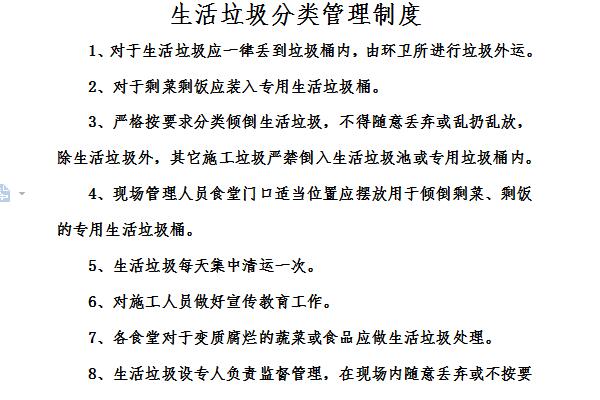
Contents of domestic waste classification management system
1. Hazardous waste.
(1) Main varieties. Including: waste batteries (nickel cadmium batteries, mercury oxide batteries, lead-acid batteries, etc.), waste fluorescent lamps (fluorescent lamps, energy-saving lamps, etc.), waste thermometers, waste blood pressure monitors, waste medicines and their packaging, waste paint, solvents and their Packaging materials, waste pesticides, disinfectants and their packaging materials, waste film and waste photo paper, etc.
(2) Put into temporary storage. In accordance with the principles of convenience, speed and safety, set up special places or containers to classify, collect and temporarily store different types of hazardous waste, and set hazardous waste signs in conspicuous locations.
(3) Collection, transportation and disposal. According to the type and quantity of hazardous waste, the collection and transportation frequency should be reasonably determined or agreed upon. The transportation and disposal of hazardous waste should comply with relevant national regulations. Encourage key environmental protection enterprises to coordinate the entire process of garbage classification, collection, transportation and disposal; cities that do not yet have terminal disposal facilities should build and improve them as soon as possible.
2. Perishable garbage.
(1) Main varieties. Including: kitchen waste generated by canteens, hotels, restaurants, etc. of relevant units, vegetable and fruit waste, carrion, meat bones, eggshells, livestock and poultry product offal generated by farmers' markets, agricultural product wholesale markets, etc.
(2) Put into temporary storage. Set up special containers for separate storage. Except for open containers that can be set up at farmers' markets and agricultural product wholesale markets, in principle, closed containers should be used for storage in other places. Food waste can be cleaned by dedicated personnel to avoid mixing with waste tableware, plastics, beverage bottles, waste paper and other impurities that are not conducive to subsequent processing, and to achieve "daily cleanup". Establish a ledger system in accordance with regulations (except for farmers' markets and agricultural product wholesale markets) to record the type, quantity, and whereabouts of perishable garbage.
(3) Collection, transportation and disposal. Perishable garbage should be transported to professional units for processing in sealed special vehicles. During the transportation process, leakage, spillage and odor control should be strengthened. Relevant departments should strengthen monitoring of the transportation and processing of food waste.
Basic principles of domestic waste classification management system
The government promotes it and all the people participate. Implement the main responsibility of the urban people's government, strengthen the demonstration and leading role of public institutions and enterprises, guide residents to gradually develop the habit of active classification, and create a good atmosphere for the whole society to participate in garbage classification.
Adapt measures to local conditions and proceed step by step. Comprehensively consider the actual conditions of local climate characteristics, development levels, living habits, waste composition, etc., reasonably determine the implementation path, and promote the classification of domestic waste in an orderly manner.
Improve mechanisms and innovate development. Give full play to the role of the market and form an effective incentive and restraint mechanism. Improve relevant laws, regulations and standards, strengthen technological innovation, and use information technology to improve the efficiency of waste classification.
Coordinated advancement and effective connection. Strengthen the connection between garbage classification collection, transportation, resource utilization and terminal disposal to form a unified, complete, adaptable, collaborative and efficient whole-process operation system.
The editor recommends:
The domestic waste classification management system is a free template. You can download the source file for you to edit, modify and replace. Huajun Software Park also providesMeasures for the Management of Permits for the Discharge of Urban Sewage into the Drainage Pipe Network,Measures for the Administration of Single-Purpose Commercial Prepaid Cardsdownload.






































it works
it works
it works